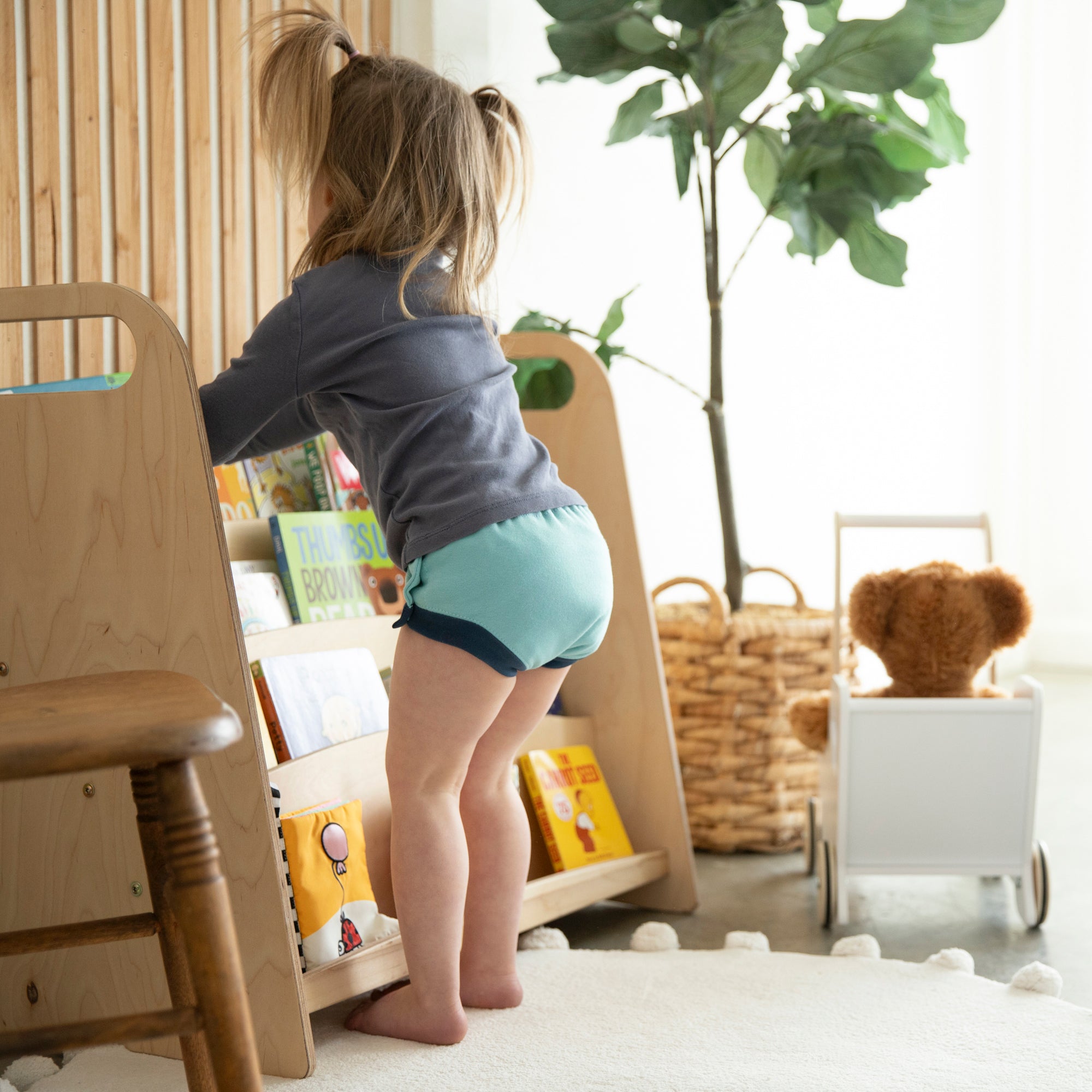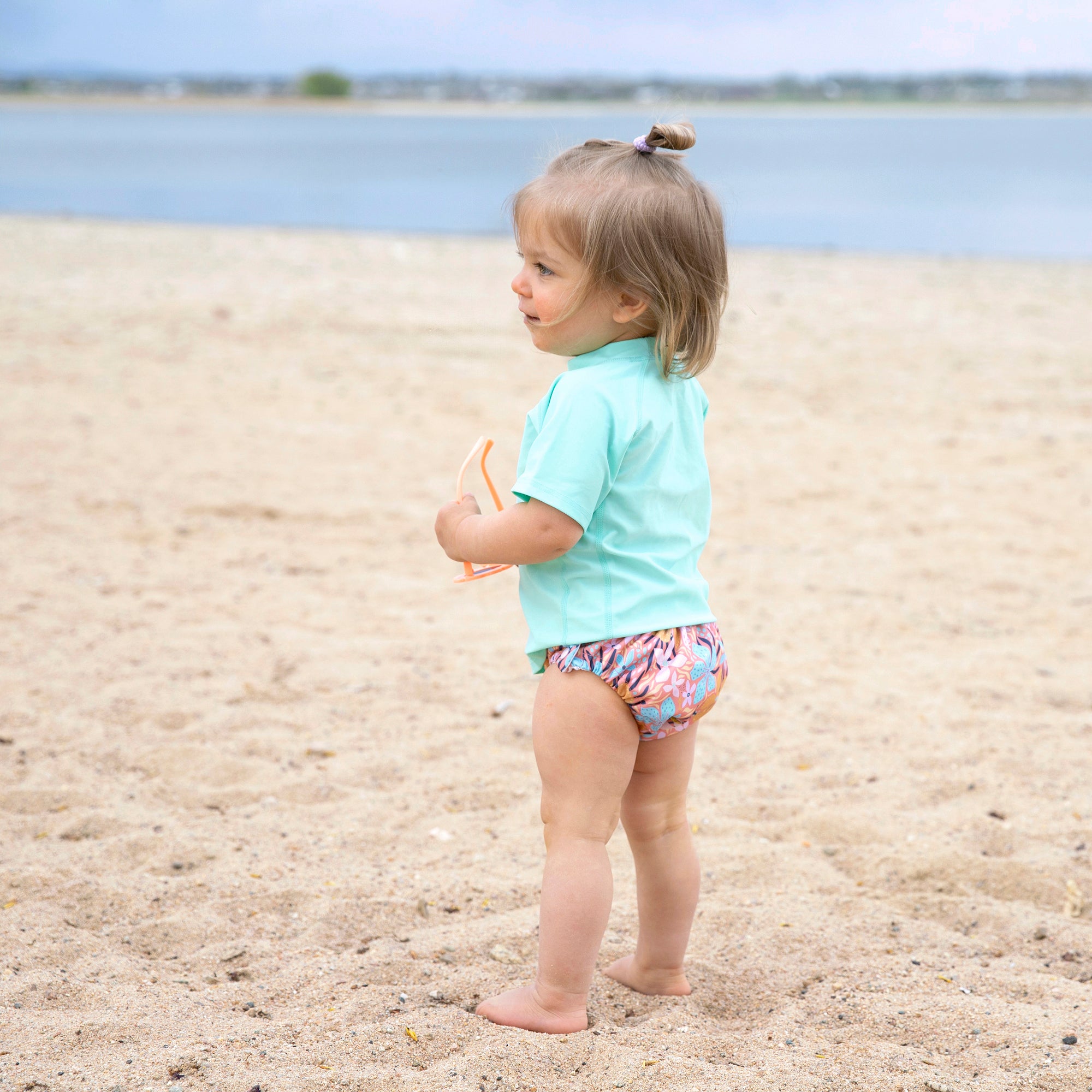Prefolds are one of my favorite diapers to recommend. They are made of natural fibers, easy to clean, durable, and simple to use. If they are made of the proper fabric and thickness, they are also very absorbent. All prefolds are not made alike. The design and fabric can vary from one manufacturer to the next.
Prefold definition: Rectangular diapers that have more layers in the middle and fewer layers on the sides.. You may see the prefolds labeled as 4x8x4 or 4x6x4. That pertains to the layers of fabric in the diaper. 4x8x4 = 4 on both sides, and 8 in the middle 4x6x4 = 4 on both sides, and 6 in the middle Uses Prefolds can be folded and laid into a trim cover, or folded and fastened on baby. Prefolds need a waterproof cover over the top. Other uses: · Trifold and use as an insert · Grab for a burp cloth or a changing table mishap. · Use for cleaning cloths once they have fulfilled their purpose for diapers Cost: Cost can vary from $1.00 - $8.00 per prefold. How many do you need? Diapers: Newborn: 20-24 diapers (plus 7-8 covers) 6-12 months: 14-18 diapers (plus 4-5 covers) 12-24 months: 12-16 diapers (plus 3-4 covers) Potty Learning: 4-8 diapers (plus 2 covers) *A single Thirsties Duo Wrap or Thirsties Diaper Cover can be wiped clean and reused several times before requiring a full washing. Sizing: Prefolds come in sized versions, or duo-sized versions. Sized versions come in sizes from newborn to XL. Duo-sized versions such as the Thirsties Duo Hemp Prefold come in size 1 and 2. Different types of prefolds: Sometimes a prefold is marked as a certain type of prefold. Those labels can mean where the prefold is made, or what the prefold is made out of, regardless of brand. Indian Prefold Typically made from 100% cotton gauze. Thinner fabric and thread is used, so may be less durable than a heavier duty prefold such as a Chinese Prefold, but softer and more absorbent than a Chinese Prefold. Wash 3x before use. CPF/Chinese Prefold Made in China and exported. Typically made from 100% cotton twill. Comes in multiple absorbencies and sizes. Pilling may be an issue and they are not as soft as Indian Prefolds, but fabric and stitching is very durable. Wash 3x before use. UBCPF/Unbleached Chinese Prefold Made in China and exported. Made from 100% unbleached cotton twill. Comes in multiple absorbencies and sizes. Pilling may be an issue and they are not as soft as Indian Prefolds, but fabric and stitching is very durable. The unbleached diapers have not gone through a whitening process, and are hence softer. They come with many of the original cotton oils still in the fabric and may require extensive washing to make them absorbent. Wash 7x before use. DSQ/Diaper Service Quality These prefolds are considered to be the best quality, but any diaper can be called a DSQ as there is no minimum absorbency or thickness requirement to get that classification. Stay-Dry Prefold Cotton prefold made traditionally with more layers in the middle and less on the sides, but back side of prefold has a fleece layer. What is the difference in the materials? Prefold diapers can be bleached or unbleached. Unbleached fabrics will be softer and more durable than bleached. 100% cotton twill – very durable and absorbent 100% woven cotton (Birdseye; Terry/Flannel, Gauze)- durable and absorbent Bamboo/cotton – very soft and absorbent, resistant to mold and mildew Bamboo terry - very soft, resistant to mold and mildew Bamboo velour – very soft, resistant to mold and mildew (not for use with a Snappi Fastener) Hemp/cotton fleece – more durable and absorbent than cotton alone, resistant to mold and mildew Hemp/cotton jersey - more durable and absorbent than cotton alone, resistant to mold and mildew (not for use with a Snappi Fastener) Hemp/cotton muslin - more durable and absorbent than cotton alone, resistant to mold and mildew Cotton/polyester (inner layers are polyester or a blend) – more durable than cotton alone, but less absorbent Cotton/rayon (inner layers are rayon or a blend) – more durability than cotton alone, but less absorbent Washing Prep: All prefolds will need to be washed AT LEAST 3 times to rid them of the natural oils and waxes present in the fibers. As a guideline, wash bleached prefolds at least 3 times, and unbleached prefolds 7 times before using. Maximum absorbency should be reached after 8 washes. Prefolds will generally shrink 5-10% after washing. Care: Prefolds are a durable diapering option, and natural fibers are easier to clean than man-made fibers. Please follow the manufacturer’s washing instructions. Folding Trifold Method Trifolding means folding the diaper into thirds. This can also be called a Newspaper Fold. You do not need to fasten the diaper on baby when using this method as the diaper is laid into the waterproof cover. When Trifolding, the cover you choose to use over the top needs to be trim and snug like our Duo Wrap. Here is a diagram of the trifold method in the Thirsties Duo Wrap:

The prefold MUST be up against the baby’s skin. If the cover sags, the diaper will sag, and leaks could be an issue. Trifolding may be done with any kind of prefold. Fold & Fasten Method If you are using a generously sized cover such as our Diaper Cover, then you will want to fold and fasten the prefold on baby. A sized cover may not be trim enough to hold a trifold prefold in place. Keeping the diaper up against baby’s skin is very important! You may also prefer to fasten the diaper if there are leak issues. There are many different ways to fold a prefold or flat diaper. The type of fold you use can depend on where you need the most absorbency, as well as how large the diaper is that you are folding. Folding Techniques Angel Wing Fold: http://iownappies.co.uk/Microsoft%20Word%20-%20Terry%20Folds.pdf Kite Fold: http://iownappies.co.uk/Microsoft%20Word%20-%20Terry%20Folds.pdf Origami Fold: http://iownappies.co.uk/Microsoft%20Word%20-%20Terry%20Folds.pdf Safari Fold http://www.diaperjungle.com/folding-diapers.html Terry Square Fold: http://iownappies.co.uk/Microsoft%20Word%20-%20Terry%20Folds.pdf Triangle Fold: http://iownappies.co.uk/Microsoft%20Word%20-%20Terry%20Folds.pdf Fastening If you choose to fold and fasten the prefold, here are your options:
- Snappi
- Diaper Pins
- Boingo fasteners





Great, informative article. You got to the point but still gave plenty of information. :) There are so many different kinds of diapers these days that it can be overwhelming to choose what kind you want. I started using prefolds 9 years ago when I began cloth diapering my third child. I’ve been able to cloth diaper two more of my children and it’s amazing how the cloth diapering world has changed since then, yet prefolds are still around and still popular. :)
Thank you for linking up different folds… I only know the trifold and oragami fold, and I’m expecting this summer and wanted to try some prefolds with covers. I appreciate the information!
At first prefolds looked so complicated, but they are growing on me! I think I will try them for sure with my newborn. I actually saw a video that highly recommended a Thirstie’s cover with a prefold tucked in for newborns. Made it look really easy.
Thanks! Lots of great info, I’m new to cloth diapering and checking all my options.
This is an awesome reference post! I bookmarked it! I have a HEAVY wetter so I’m trying to learn more about prefolds and really want to try Thirsties!!
You're viewing 11-15 of 25 comments